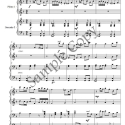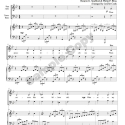April 29th, 2014
Freestyle is my favorite way to accompany vocalists. To me, freestyle is playing by ear what I feel at the time without written music. It takes years of practice… of course… to get to this point of playing 😉 Dad was the first person I ever accompanied in my early years of being church pianist. He taught me accompaniment tips along the way such as “Follow the soloist”…a MUST for the church pianist.
I do play for soloists that prefer to follow me but I’m trying to help them feel more comfortable being the leader. After all…the church pianist is just the background support for the soloist.
Below, is a recent recording of me playing for my dad. Our parents were visiting with us this past week and Dad sang this solo in our church.
I love to accompany my dad!
Tags: accompanying the vocalist, church pianist, freestyle piano accompaniment
Posted in Accompaniment tips, Miscellaneous tips, Special Music, Videos, Vocal | 2 Comments »
April 16th, 2014
There are certain songs that are a challenge for the church pianist to accompany. “Down From His Glory” is one of those songs!
In the video below, Duane Ream and Faye Lopez share some of their insight on accompanying the vocal soloist for “Down From His Glory”.
The following video excerpt came from last year’s Hymn Playing Master Class workshop at the annual Wild’s Music Conference. Please excuse the shaky quality of the video. I didn’t have a tripod available.
I want to thank the pianist for granting me permission to share this video excerpt. He did a great job with his impromptu accompaniment; providing others with an opportunity to learn more about accompanying a vocal solo.
This video was taken during the “critique” session of the class when someone would volunteer to play either a piano solo, prelude style piece or accompaniment style.
Duane Ream, one of the workshop leaders, also volunteered to sing…making it easier for the volunteer pianist to share his accompaniment style. *Please note that Duane sang an octave lower on purpose for the chorus… since it was out of his vocal range 🙂 At least he was willing to help the pianist 🙂
I’ve thought about providing a couple visual examples of the accompaniment patterns Faye was trying to convey to the pianist. Keep in mind…they wouldn’t be note for note what she played but I could produce something very similar. Who would be interested?
Tags: accompaniment, accompanying, accompanying a vocal solo, church pianist, piano accompaniment, Wilds music conference
Posted in Accompaniment tips, Special Music, Videos, Vocal | 11 Comments »
April 4th, 2014
If you have been a church pianist for very long or played in different churches as church pianist…then you may have run across this scenario…”playing for an inexperienced leader”.
The intention of this article is not meant to minimize the willingness and faithfulness of the inexperienced leader but rather to give constructive pointers to church pianists on how to deal with such a situation.
My dad, who was my first leader to follow, emphasized to me the importance of the pianist following the leader. I’m thankful for his teaching and preparing me for my role as church pianist. He was the best teacher!
Over time, through experience…I have learned there are exceptions to rules 🙂
I have had to play for at least several different leaders in various situations who just didn’t know “how” to lead and were doing the best they could. Not all of them were non-musical people either. I’ve had the joy of helping some of those leaders along…ONLY because of having a trusting relationship with them; giving me the liberty to do so.
I’ve found it necessary to “lead” as a pianist in some cases IF it was the only way to keep everyone singing together at the same tempo.
On occasion, when a lay person in our church has had to substitute for our regular leader…he will ask me before the service… to help him during congregational singing by keeping things moving since he’s not comfortable with leading.
The following video (taken from the 2013 Wild’s Music Conference) contains more discussion about this topic of “The Experienced Church Pianist vs. The Inexperienced Leader.”
My favorite quotes from the video:
“Part of our role is… we’re support, we’re ministry, we’re behind-the-scenes…serving and helping someone else try to do their job effectively…part of the philosophy of being a good church pianist.”
~ ~ Faye Lopez ~ ~
“You can infuse the service with energy and vitality in the singing…from the keyboard.”
~ ~ Duane Ream ~ ~
Enjoy the following brief… yet informative video on:
“The Experienced Church Pianist vs. The Inexperienced Leader”
Tags: church pianist, experienced church pianist, inexperienced leader, leader
Posted in Accompaniment tips, Choir, congregational singing, Important Information, Miscellaneous tips, Offertories, Special Music, Videos, Vocal | 4 Comments »
March 24th, 2014
Just thought I’d share a very informal video shooting of my latest choir/congregational arrangement of “It is Well”.
It was a last minute decision to video the choir and didn’t have a tripod….so excuse the shaky quality.
At least you can get a rough idea of how the arrangement sounds.
The end is kind of funny because our Pastor thought we were done BEFORE we were done. He had us sing it again because he liked it so much AND because he wanted to hear the end without interruption:)
It just so happened that the first recording was our best.
I appreciate all of our choir members taking the time to attend choir practice each week. They are a blessing!
Tags: easy satb choir arrangement, it is well, jenifer cook
Posted in Choir, Special Music, Videos, Vocal | 2 Comments »
March 22nd, 2014

Finally! Just finished a sacred piano duet (early advanced) of “Come Thou Fount”.
Many people have requested that I write piano duets. I had SO much fun writing this one that I plan to do more.
Below is an audio sample of this piano duet of “Come Thou Fount”.
Early advanced sacred piano duet, 4 pgs.
*Price covers two copies.
Price: $5.25
Tags: come thou fount, piano duet, sacred piano duet
Posted in Music Store, Offertories, Special Music | 5 Comments »
March 19th, 2014

Just to let my readers know I have a facebook page as of today.
It’s a less formal place for me to share videos, writing project updates, helpful links, etc.
I’m not sure how to share a link to my facebook so you will have to search me out as: Jenifer Cook (musician/band) category).
Hope to see you there!
Posted in Important Information | 4 Comments »
March 18th, 2014

I created this SATB choir arrangement of “A Glorious Church” just to have an easy one on hand. Our 30 minute choir rehearsals limit us on how much material we can cover. So…this arrangement came in handy!
I would eventually like to create a collection of easy choir arrangements like this.
Special note: I was short on time when I created the piano score for this arrangement…so I left out the men’s part. The choir vocal score contains all the parts.
Click on the song titles below to download your FREE arrangement of this unison choir hymn.
A Glorious Church (choir vocal score)
A Glorious Church (piano score)
Tags: a glorious church, choir arrangement, free choir arrangement, free satb choir arrangement
Posted in Choir, Free music, Special Music, Vocal | No Comments »
March 6th, 2014

I know…I’ve been fairly quiet! Just to let you know why 🙂
I’ve been working on a “Background Invitation” collection that I hope to finish soon! I hope to have at least twelve songs in this collection. Just started on the ninth one.
I also woke up this morning with ideas for a piano duet of “Come Thou Fount” and started writing before it left me! Can’t wait to share this one!
Back to writing….
Posted in Uncategorized | No Comments »
March 3rd, 2014

I know other church pianists would agree that it’s so important to be training other pianists in the church to become church pianists or simply to fill in while other pianists are out of town.
At our church, we have a couple college male students who commute to our church..one of which helps us out on the piano, among many other areas. There are actually a total of three pianists available: Sunshine, Hunter (college student) and myself. We rotate on a monthly basis to allow each one of us ample opportunity to serve.
I’m usually out of town at least 6 times during the school year calendar. To provide extra experience for Hunter, I’m having him play second piano along with me when I accompany instrumental specials for offertory. This opportunity allows him to learn the art of accompanying with an “on hands” approach. (A lot of “give and take” in rhythm occurs when accompanying someone to sing or play their instrument.)
Hunter also plays second piano for congregational singing on Sunday nights and main piano on Wednesday nights giving him a chance to play introductions on his own. He has also used the congregational notebook I’m creating (which was destroyed in our church flood)..another story. He says the congregational notebook was a great help to him.
I can’t wait to start creating the congregational notebook again! I do have some of the songs in the computer…but most were not in the computer due to me accidentally deleting the original files on my computer about a year ago…(which was also a about a year’s worth of music…ugh)
Hunter has progressed by leaps and bounds! I’m so excited to see how the Lord is preparing him for future ministries. I’m also honored that the Lord has allowed me to be a part of his training. Unfortunately, we only have him one more year since he’ll be graduating.
It seems God has allowed our church to be a training post for young male college students training in the area of music ministry and children’s ministries over the past (at least six years). We’ve been SO blessed to be a part of this important training process.
Tags: church pianist, congregational singing, pianist, piano
Posted in congregational singing, Offertories | No Comments »
February 18th, 2014
I am VERY excited about this arrangement! This particular arrangement has been in the making since December but took plenty of time to refine it before sharing the finished product.
It is Well takes on a whole new meaning to those who have heard the story behind the writing of this hymn.
Click on the following link to read about the heart-rending events that led to the writing of “It is Well”. Only by God’s grace…this song was born.
It is Well (the story behind the song)
Easy SATB choir with congregation arrangement. 8 pgs.
*Price covers multiple copies
You need to have the Audio Player Plugin installed to use this shortcode
Price: $8.00
Tags: choir arrangement, it is well, jenifer cook
Posted in Choir, congregational singing, Music Store, Special Music, Vocal | 4 Comments »






